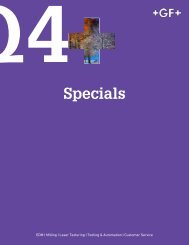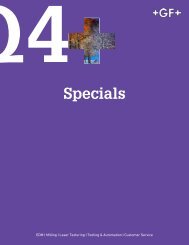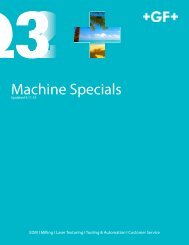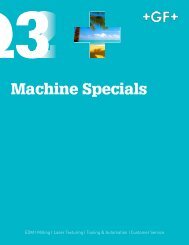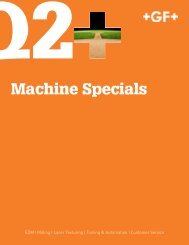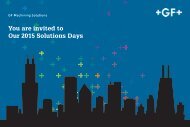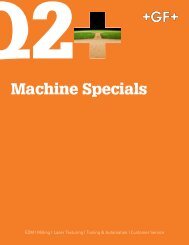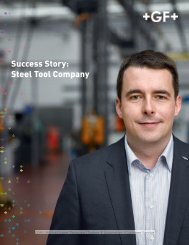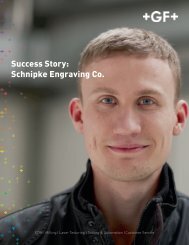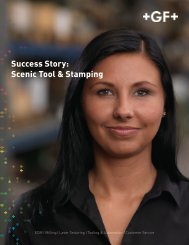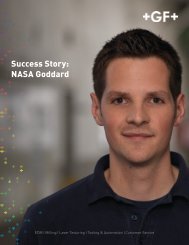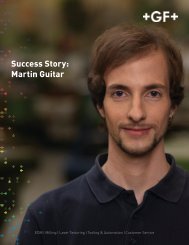Custom Etch, Inc.
You also want an ePaper? Increase the reach of your titles
YUMPU automatically turns print PDFs into web optimized ePapers that Google loves.
Success Story:<br />
<strong>Custom</strong> <strong>Etch</strong>, <strong>Inc</strong>.<br />
EDM I Milling I Laser Texturing I Tooling & Automation I <strong>Custom</strong>er Service
Shop Has Every Surface Covered With Added<br />
5-Axis Lasers<br />
With the emergence of 5-axis laser texturing, it was thought<br />
that the innovative technology would significantly reduce the<br />
use of, if not completely replace, the traditional process of<br />
photo-printed acid etching. But at <strong>Custom</strong> <strong>Etch</strong>, that prediction<br />
could not be further from the truth.<br />
<strong>Custom</strong> <strong>Etch</strong> <strong>Inc</strong>. in New Castle, Pa., is a 30-person shop<br />
that specializes in photo-printed acid etching, and has done<br />
so since its establishment in 1982 by Henry Melonio and his<br />
brother Donald Melonio. However, the shop recently invested<br />
in 5-axis laser-texturing technology, and instead of replacing<br />
the shop’s legacy processes, two laser systems have proven<br />
a perfect partner to <strong>Custom</strong> <strong>Etch</strong>’s chemical etching and engraving<br />
operations.<br />
As a result of marrying together the chemical and laser<br />
processes within its operations, <strong>Custom</strong> <strong>Etch</strong> can precisely<br />
and efficiently generate virtually any desired surface pattern<br />
or texture faster than those shops relying solely on chemical<br />
processes. Additionally, laser texturing significantly boosts<br />
<strong>Custom</strong> <strong>Etch</strong>’s flexibility when it comes to imparting complex<br />
organic textures and geometric patterns onto complicated<br />
mold cavities, cores, mandrels, embossing rolls and profile<br />
embossing wheels. The shop’s textures and patterns can be<br />
found on everything from housewares, building products and<br />
automotive parts to lawn and garden equipment, toys, medical<br />
components and more.<br />
“When coupled with our experience, efficiency and excellent<br />
customer service, 5-axis laser-texturing technology enables<br />
us to further help our customers discover and explore unique<br />
design opportunities,” said Don Melonio, vice president of<br />
<strong>Custom</strong> <strong>Etch</strong>. “The technology propels forward the development,<br />
prototyping and manufacturing of our customers’ products.<br />
It also provides levels of accuracy, detail, and repeatability<br />
– especially helpful with mold repair areas – that are<br />
unachievable using conventional etching processes.”<br />
<strong>Custom</strong> <strong>Etch</strong>’s laser systems are GF AgieCharmilles LASER<br />
1000 5Ax and LASER 1200 5Ax 5-axis laser-texturing machines<br />
that provide fully digitized manufacturing processes for<br />
generating detailed and nuanced texturing, microstructuring,<br />
engraving, marking and labeling. The technology is faster,<br />
quieter as well as more repeatable, flexible and environmentally<br />
friendly when compared with conventional processes,<br />
both mechanical and chemical.<br />
Both LASER 5Ax systems machine from high-quality digital<br />
images and CAD data, allowing for completely reproducible<br />
results in both large and small job lot sizes. The mapping<br />
systems of the machines use a 50-W Ytterbium pulsed laser<br />
to render the desired patterns or textures. And while chemical<br />
etching, for instance, can only produce in three to five layers,<br />
GF AgieCharmilles’ laser-texturing technology can achieve 30<br />
to 50 layers to provide much higher levels of detail.<br />
The machines also come standard with programmable, tilting<br />
laser heads, high-resolution cameras with integrated illumination<br />
for fine positioning, integrated touch probes, dust<br />
exhausts, central lubrication systems and lenses of varying<br />
focal strengths. In addition to being a faster and more precise<br />
means of producing patterns and textures with increased reliability,<br />
laser texturing offers pollutant-free operation, producing<br />
no fluids, slurry or chips. Dust particles produced by the
process are automatically extracted by vacuum to guarantee a<br />
clean process.<br />
“The LASER machines are basically 5-axis milling machines<br />
with lasers instead of milling heads,” explained Melonio.<br />
“However, GF AgieCharmilles created a completely new proprietary<br />
software to run the laser heads from common IGES<br />
and STEP files. Programming is easy and basically requires<br />
only the same programming skills as would be needed to<br />
machine a simple component on a conventional CNC machine<br />
tool.”<br />
Rhino is <strong>Custom</strong> <strong>Etch</strong>’s preferred mapping/imaging software<br />
used to create surface designs and transfer them on to mold<br />
cavity surfaces for laser texturing. These same files are the<br />
ones used by the machinist that cut the tool cavity shape on<br />
milling machines.<br />
According to Melonio, the key to the laser-texturing operation<br />
is positioning the laser’s focal point at the correct distance<br />
from the workpiece surface. Material ablation rate is based<br />
on the frequency and power setting of the laser. Power settings<br />
can be adjusted anywhere from 0 to 100 percent, and the<br />
frequency from a level of ten to 90, for instance, to determine<br />
how fast the laser will ablate/cut material.<br />
Because they use fiber lasers, the systems are extremely precise<br />
and can remove microns at a time. This allows <strong>Custom</strong><br />
<strong>Etch</strong> to make very light and shallow cuts or not make a cut<br />
at all, but instead use the lasers to only change the color of a<br />
part’s surface for strictly aesthetics if so desired.<br />
With its most recently acquired LASER 1200 5Ax, <strong>Custom</strong> <strong>Etch</strong><br />
increases the range of part sizes to which it can apply surface<br />
texturing. The machine’s table measures 31.5” in diameter and<br />
handles workpieces weighing up to 3,747 lbs.<br />
<strong>Custom</strong> <strong>Etch</strong>’s LASER 1000 5Ax is fully automated with an integrated<br />
GF AgieCharmilles pallet changing system that accommodates<br />
six modular pallets from System 3R. And according<br />
to Melonio, automation is the one factor that definitely makes<br />
the technology economical for the shop and completely justifies<br />
the investment.<br />
The pallet system uses six 11.02” square pallets that each<br />
hold workpiece fixtures an outside shop developed for <strong>Custom</strong><br />
<strong>Etch</strong>. As opposed to vises, the adjustable fixtures allow <strong>Custom</strong><br />
<strong>Etch</strong> to effortlessly load and unload workpieces.<br />
In operation, the laser machine runs an automatic probe<br />
cycle, and the part program is such that every part locates in<br />
the same place on the pallet thanks to the custom fixtures.<br />
Removing parts is as simple as loosening a couple of screws,<br />
sliding the finished part out and placing a new one into the<br />
fixture.<br />
“For our type of work, it would be tough to make money with<br />
the laser machine if it didn’t have the pallet system. Without<br />
such automation, parts would have to be manually loaded one<br />
at time into the machine, which would add huge labor costs<br />
and time to the process,” explained Melonio. “Plus, once pallets<br />
are loaded, the system basically runs unattended.”<br />
To illustrate the value of the pallet system, Melonio cites having<br />
to produce 40 soft drink plastic bottle molds – a job that<br />
entailed texturing 80 mold halves (cores and cavities) and 40<br />
base pushups. For this particular job, the shop had to process<br />
all 80 halves and all 40 base pushups through the GF<br />
AgieCharmilles 5-axis laser-texturing machine in a matter of<br />
three days to make the required delivery time. And according<br />
to Melonio, the only way the shop accomplished the task was<br />
being able to have only one person load and unload pallets<br />
while the machine continued to work non-stop and unattended.<br />
Typical part sizes run on the LASER 1000 5Ax machine measure<br />
up to 8.5” x 10.63”, so the shop uses every workable<br />
inch of its pallets. About 200 molds per week are processed<br />
through the laser machine, and the system has increased<br />
the shop’s throughput month after month without the need to<br />
dramatically increase shop floor size or workforce.<br />
However, it should be noted that <strong>Custom</strong> <strong>Etch</strong> uses its laser<br />
machines to impart complete surface textures only some of<br />
the time. Instead, explained Melonio, the lasers will most<br />
often be used first on a part, followed by the acid etching<br />
process. The reason, he said, is that imparting an 0.008”-deep<br />
pattern in a soft drink bottle mold, for instance, would take<br />
about 1.5 hours per one mold half using only laser texturing.<br />
Such a processing time is reasonable for one or two parts, but<br />
consider if the job required 60 molds with a total of 120 halves.<br />
For its dual texturing technology processing, <strong>Custom</strong> <strong>Etch</strong> will<br />
apply an acid resistant paint on to the mold cavity surfaces. It<br />
then laser textures the desired pattern on to the parts, but in<br />
such a way as to only remove the paint, not actual part material.<br />
The operation takes only minutes as opposed to hours and<br />
basically serves the same purpose as the wax transfer does in<br />
traditional chemical etching.<br />
With traditional chemical etching, a film negative of a design<br />
is etched into a magnesium plate. A wax substance is then<br />
burnished into the plate and the excess removed, leaving only<br />
the wax in the design etching. Pottery tissue is burnished on<br />
to the plate, and when the tissue is lifted off, the design comes<br />
with it, so to speak. This 2D wax rendering of the texture<br />
design can then be wrapped around a 3D surface, such as the<br />
cavity of a mold.
The process is very time consuming and requires the experience<br />
of a skilled craftsman. Reason being that when the<br />
2D pottery tissue is wrapped onto a 3D surface, the paper<br />
wrinkles anywhere there are corners or changes in surface<br />
directions. These are the places that require artistic talent for<br />
manually slicing and patching the tissue to maintain the pattern<br />
appearance.<br />
After the tissue is applied, it is sprayed with a liquid solution<br />
that releases it to leave behind the wax pattern on the part<br />
surface. This wax design left on the part is what is known<br />
as the acid resist. And when the part is submerged in acid,<br />
the places where the wax is will not be etched away, but the<br />
desired pattern will.<br />
<strong>Custom</strong> <strong>Etch</strong>’s business has grown about 40 percent over the<br />
past two years, and half of that can be attributed to the GF<br />
AgieCharmilles 5-axis laser-texturing machines – the highend<br />
capability they provide together with the speed to process<br />
jobs faster working in tandem with traditional processes. And<br />
to further increase business, <strong>Custom</strong> <strong>Etch</strong> has its sights set<br />
on a third GF AgieCharmilles laser system, the LASER 4000<br />
5x with machine travels measuring 157.5” x 118.1” x 59.1” that<br />
will further boost the shop’s part size capability where laser<br />
texturing is concerned.<br />
<strong>Custom</strong> <strong>Etch</strong> now does this extremely time consuming and<br />
laborious traditional process of transferring a 2D pattern to a<br />
3D surface in minutes with its GF AgieCharmilles 5-axis laser<br />
texturing machines. But instead of the wax resist of the traditional<br />
method, the shop uses an acid-resistant paint. Once<br />
the lasers remove the paint where is necessary for the desired<br />
pattern, the shop submerges the part into an acid bath as with<br />
the traditional process.<br />
“We’ve paired the two processes together – mapping the<br />
texture with the laser system, then removing the material with<br />
the old acid process,” commented Melonio. “The combination<br />
allows us to cost effectively process our large volumes of<br />
parts and do so as quickly as possible. It (the combination of<br />
technologies) also, like the pallet system, further increases<br />
the ROI of the laser technology as well.”<br />
Additionally, Melonio said that the laser texturing systems<br />
actually helps improve the accuracy of the acid etching<br />
process. “It also improves the repeatability,” he added. “With<br />
the old pottery tissue method, acid etching a pattern on 40<br />
different parts would result in many pattern variations from<br />
part to part. But with the lasers used instead, the surface<br />
patterns will look exactly the same from the first mold to the<br />
fiftieth to the hundredth. Identical to the point that even if the<br />
mold is damaged, a weld spot could be applied, and the GF<br />
AgieCharmilles 5-axis laser systems could impart the exact<br />
same pattern feature in the exact same place on the cavity.”<br />
Melonio also explained that the decision to use chemical,<br />
laser or both technologies is based on the requirements of<br />
the pattern design. The more intricate and complex a pattern,<br />
the better a candidate for 100 percent laser texturing. Or, if for<br />
instance, a line pattern requires tapered walls – acid cannot<br />
etch three dimensionally, so the walls of the pattern would be<br />
the same width from the top to the bottom, not tapered.<br />
In those rare occasions when <strong>Custom</strong> <strong>Etch</strong> doesn’t use the<br />
laser-texturing machines in some capacity or another, it is<br />
usually because the job involves short programs and only<br />
a couple mold components. The small volumes and simple<br />
patterns make such jobs more cost effective to process the<br />
traditional way and, according to Melonio, do not justify tying<br />
up the laser systems.
GF Machining Solutions<br />
GF Machining Solutions<br />
560 Bond Street<br />
Lincolnshire, IL, 60069<br />
USA<br />
Website: www.gfms.com/us<br />
Email: info.gfms.us@georgfischer.com<br />
Phone: 847-913-5300<br />
© Machining Solutions, 2015<br />
The technical data and illustrations are not binding.<br />
They are not warranted characteristics and are<br />
subject to change.<br />
Facebook: facebook.com/gfmachiningsolutions<br />
Twitter: twitter.com/gfms_us<br />
YouTube: youtube.com/agiecharmilles<br />
Version 1.1



